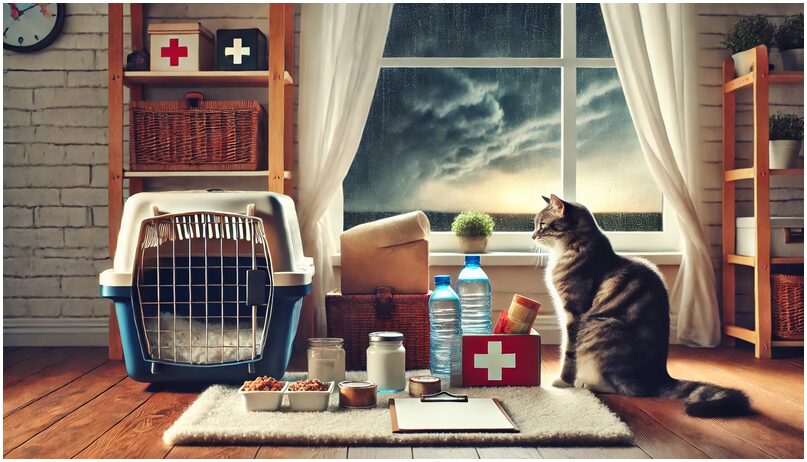Disasters are unpredictable, and when they strike, our first priority is often the safety of our loved ones. For cat owners, that includes having a disaster preparedness plan in place for their cats. Whether it’s a natural disaster like a hurricane, earthquake, wildfire, or a more localized crisis such as a house fire or power outage, having a plan in place for your cat’s safety can make all the difference.
In this guide, we’ll cover everything you need to know about preparing for a disaster with your cat in mind, from assembling a feline emergency kit to creating a disaster plan that works for both of you. Let’s dive in!
Why Disaster Preparedness Matters for Cats
Cats can become stressed or frightened during disasters, and their instinct to hide can make them harder to find when time is of the essence. In some situations, you may need to evacuate quickly, and without proper preparation, your cat could be left behind or exposed to danger.
By planning ahead, you can ensure your cat has everything they need to stay safe, calm, and healthy. Preparation gives you the peace of mind that you can act quickly and efficiently, even in stressful situations.
Creating a Feline Emergency Kit
Just like humans, cats need essential supplies to get through an emergency. Here’s what should be in your cat’s emergency kit:
1. Food and Water
- Cat Food: Pack at least a two-week supply of your cat’s regular food, including canned or dry options. Make sure to rotate the stock to keep it fresh.
- Water: Store a two-week supply of clean drinking water specifically for your cat. Plan on about ½ cup to 1 cup of water per day, depending on their size.
- Bowls: Bring collapsible food and water bowls for portability.
2. Medications and First Aid
- Medications: If your cat requires medication, ensure you have a two-week supply on hand. Include instructions for dosing and administration in case someone else needs to assist.
- First Aid Kit: Include items like bandages, antiseptic wipes, tweezers, and a small pair of scissors. You may also want a guide on basic pet first aid.
3. Litter and Waste Supplies
- Litter Box: A portable, collapsible litter box is ideal for emergencies.
- Cat Litter: Pack enough litter for at least two weeks.
- Waste Bags: Have plastic bags or disposable waste bags for easy cleanup.
4. Identification and Important Documents
- ID Tags: Make sure your cat’s collar has up-to-date ID tags with your current contact information.
- Microchip: Ensure your cat’s microchip information is registered and updated.
- Photos: Keep current photos of your cat in case they become lost, as well as any distinguishing features that could help with identification.
- Vet Records: Include copies of your cat’s vaccination records, medical history, and any necessary prescriptions.
5. Comfort Items
- Blankets and Towels: Familiar smells can help reduce stress for your cat, so pack a few small blankets or towels that your cat enjoys.
- Toys: Include a few favorite toys to help keep your cat entertained and reduce anxiety.
6. Carrier
Sturdy Carrier: Make sure your cat’s carrier is durable, easy to carry, and well-ventilated. A carrier will be necessary for evacuation or transport to a safe location. Your cat should be familiar with it to minimize stress.
For tips on putting together a feline disaster preparedness kit, check out Cornell Feline Health Center’s Disaster Preparedness post.
Developing a Disaster Plan
In addition to having an emergency kit, you should also develop a comprehensive disaster plan for your cat. Here’s how:
1. Know Your Evacuation Routes
- Plan out at least two evacuation routes in case of emergencies, especially if you’re in a region prone to hurricanes, wildfires, or flooding.
- Make sure your cat’s carrier is easily accessible and in good condition for quick use.
- Keep your cat’s emergency kit by the carrier for easy grab-and-go access.
2. Create a Shelter Plan
- Identify pet-friendly shelters, hotels, or boarding facilities outside your immediate area. Not all shelters accept pets, so it’s crucial to know where you and your cat can go ahead of time.
- Consider asking friends or family members if they would be willing to care for your cat in the event of an emergency.
3. Emergency Contacts
- Share your emergency plan with a trusted friend or family member, particularly if they live nearby and could help in a crisis.
- Include your veterinarian’s contact information in your plan.
4. Practice Safe Evacuation
- Familiarize your cat with their carrier by leaving it out regularly and offering treats inside. In a stressful situation, a cat may be reluctant to enter a carrier, so ensuring they are comfortable with it beforehand can help.
- Do mock evacuations to practice grabbing your emergency kit, carrier, and leaving the house quickly with your cat.
What to Do During a Disaster
During a disaster, your priority is to stay calm and act quickly. Here’s a step-by-step approach to managing the situation with your cat in mind:
1. Evacuating With Your Cat
- Place your cat in their carrier before you leave, even if you think you won’t be gone long. Cats can become frightened and hide, making it harder to find them if you need to leave in a hurry.
- Bring your cat’s emergency kit with you, including food, water, and medications.
- Make sure your cat is wearing their collar with ID tags at all times in case you become separated.
2. Staying Safe at Home
- If evacuating isn’t possible, move to the safest area of your home. Choose a room without windows, like a bathroom or a basement, to protect against flying debris or other hazards.
- Keep your cat inside and away from dangerous areas like floodwaters, smoke, or broken glass.
- Provide comfort items, such as blankets and toys, to help keep your cat calm.
After the Disaster
After the danger has passed, it’s important to monitor your cat for signs of stress, injury, or illness. Cats can be sensitive to changes in their environment, and even after the immediate threat is over, they may be anxious or fearful.
1. Check for Injuries
- Look over your cat for any signs of injury or illness, such as cuts, burns, or breathing issues. If anything seems off, contact your veterinarian right away.
2. Reintroduce Your Cat to Their Home
- If you evacuated, your home may have suffered damage. Inspect the area for hazards like broken glass, exposed wires, or other dangers before letting your cat roam freely.
- Give your cat time to adjust. They may be frightened or stressed, so provide them with familiar items like their favorite bed or blanket to help them feel secure.
Conclusion: Being Prepared Saves Lives
Disaster preparedness isn’t just for humans—it’s essential for your cat’s safety and well-being too. By planning ahead, creating an emergency kit, and practicing evacuation procedures, you can ensure that your feline friend is as ready as you are to face the unexpected.
Taking these steps not only gives you peace of mind but also increases the chances that you and your cat will come through any crisis together, safe and sound. Stay prepared, stay safe, and make sure your cat is always part of the plan!
Do you have any tips or experiences to share about disaster preparedness for your pets? Let us know in the comments!







Thank you for the advice! A thing that I think would be nice, is if you added a voiceover. I could probably do that, as well as make art for your blogs! Just lmk :3
(I think you know who I am lol)
Just want to say your article is simply excellent. Thanks a million.